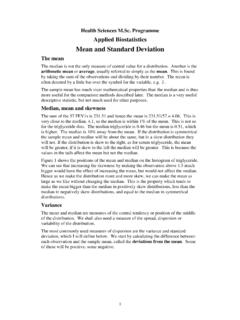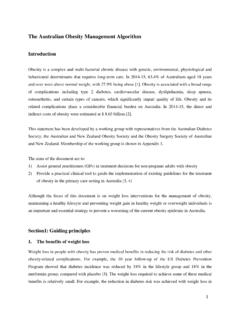Transcription of Interpretation of research results
1 Interpretation of research results Martin Bland (adapted from work by Trevor Sheldon) Why do we need to know about statistics? We are now in the era of evidence based nursing and the research -led NHS. This means that all healthcare professionals need to be able to read and understand evidence. This evidence often uses statistical methods. There is nothing particularly new about this, of course, and it was at the heart of the earliest development of modern nursing. Florence Nightingale, known as The Passionate Statistician , was an early member of what is now the Royal Statistical Society and made innovations in statistical methods to use numerical data to promote improvements in healthcare.
2 research evidence in usually published in scientific papers and in this lecture we shall look at the basic statistical ideas used in the presentation and Interpretation of evidence in such papers. For example, this is the summary of a paper from a nursing journal: Evaluation of an Electrolyte Replacement Protocol in an adult Intensive Care Unit: A retrospective before and after analysis Zahra Kanji and Karleen Jung Background Electrolyte imbalances are frequently encountered in the Intensive Care Unit (ICU) and protocol-driven interventions may facilitate more timely and uniform care.
3 Objective To compare the effectiveness and timeliness of electrolyte replacement in an adult ICU before and after implementation of an Electrolyte Replacement Protocol (ERP) and to assess nurse and physician satisfaction with the ERP. Methods Health records of adult patients who experienced hypokalaemia, hypomagnesaemia, or hypophosphataemia in the ICU during the study periods were retrospectively reviewed. Effectiveness of the ERP was assessed by the number of replacement doses indicated but not given and the number of doses and total dose required to normalise the low electrolyte level.
4 Timeliness was evaluated by the time between the laboratory reporting the low electrolyte level and administration of the replacement dose. Nurse and physician satisfaction with the ERP was assessed through a written survey. results After implementation of the ERP, the number of replacement doses indicated but not given was reduced for magnesium from 60% to 35% (p = ) and for phosphate from 100% to 64% (p = ). The time to replacement was reduced for potassium from 79 to 60 min (p = ) and for magnesium from 307 to 151 min (p = ). Nurses and physicians were satisfied with the ERP.
5 Conclusions Implementation of an ERP resulted in improvements in the effectiveness and timeliness of electrolyte replacement and nurses and physicians were satisfied with the ERP. Intensive and Critical Care Nursing 2009; 25: 181-189. If we want to know whether to implement a similar electrolyte replacement protocol in our unit, we need to understand not just the nursing but also the research methods used in the paper. In this lecture, we shall look first at how we summarise and present data, then at how we interpret them. Measures of disease or outcome When we carry out research in nursing, we usually need to measure either disease or the outcome of an intervention.
6 The way we do this affects how we present and summarise information. We usually distinguish between: qualitative measures, whether something is present or absent, or how things are divided into different categories, and quantitative measures (how much of something there is). Examples of qualitative measures include disease diagnosed, presence of myocardial infarction, death or survival. Whether an indicated dose was given or not is a qualitative measure. Examples of quantitative measures include blood pressure, PaO2, and urine output. Time to replacement of electrolyte is a quantitative measure.
7 Where a qualitative measure has only two possible outcomes, yes or no, dead or alive, we call it dichotomous. In this lecture we shall look at some ways of dealing with dichotomous and with quantitative measures. Dichotomous measures We usually calculate the risk, the proportion of people in the group that show the outcome of interest ( develops the disease, dies, heals). In this usage, risk can be the chance of good things happening as well as bad. If 7 out of 100 patients have a pressure sore during a hospital stay, the risk of in-hospital pressure sore is 7/100 = or 7%.
8 Odds is the number of people with the outcome divided by the number without the outcome. If 7 out of 100 patients have a pressure sore during a hospital stay, 93 do not, so odds of in-hospital pressure sore is 7/93 = Comparing risks In the study of protocol directed sedation by nurses (Brook et al. 1999), patients in the protocol-directed sedation group also had a lower tracheostomy rate compared with patients in the non-protocol-directed sedation group (10 of 162 patients [ ] vs., 21 of 159 patients [ ]). Risk difference = Control risk minus Intervention risk = = percentage points.
9 If risk difference = 0 then there is no difference in risk between two groups. Relative Risk or Risk Ratio = Intervention risk / Control risk = / = This is less than half the risk. If relative risk = 1 then there is no difference in risk between the two groups. If relative risk is less than 1 then the risk in intervention group is lower than the risk in comparison group. If relative risk is greater than 1 then the risk in the intervention group is higher than in the comparison group. Odds ratio = Intervention odds / Control odds =.(10/(162 10)) / (21/(159 21)) = = ( ( )) / ( ( )) = Odds ratio is also if there is no difference, less than 1 if the risk in the intervention group is lower than the risk in the comparison group, and greater than 1 if the risk in the intervention group is higher than in the comparison group.
10 Summarising quantitative data The first question we usually ask about quantitative data is how much? . What is the typical or the average value? Two summaries of data which we often use for this are the mean and the median. To find the mean of a set of measurements, we add all the values together and divide by the number of observations. This is sometimes called the arithmetic mean. To find the median, we take the value of the middle observation when all the observations are put in order; 50% of the observations lie above the median and 50% lie below.




